Animal Enrichment and Captive Wildlife
VerifiedAdded on 2020/02/24
|8
|1718
|216
AI Summary
This assignment delves into the crucial topic of environmental enrichment for captive animals. It emphasizes the necessity of providing stimulating and engaging environments to enhance their physical and psychological well-being. The document discusses various enrichment techniques, including puzzle feeders, foraging activities, social interaction, and sensory stimulation. Specific examples of successful enrichment programs in zoos are also analyzed, highlighting their positive impact on animal welfare.
Contribute Materials
Your contribution can guide someone’s learning journey. Share your
documents today.
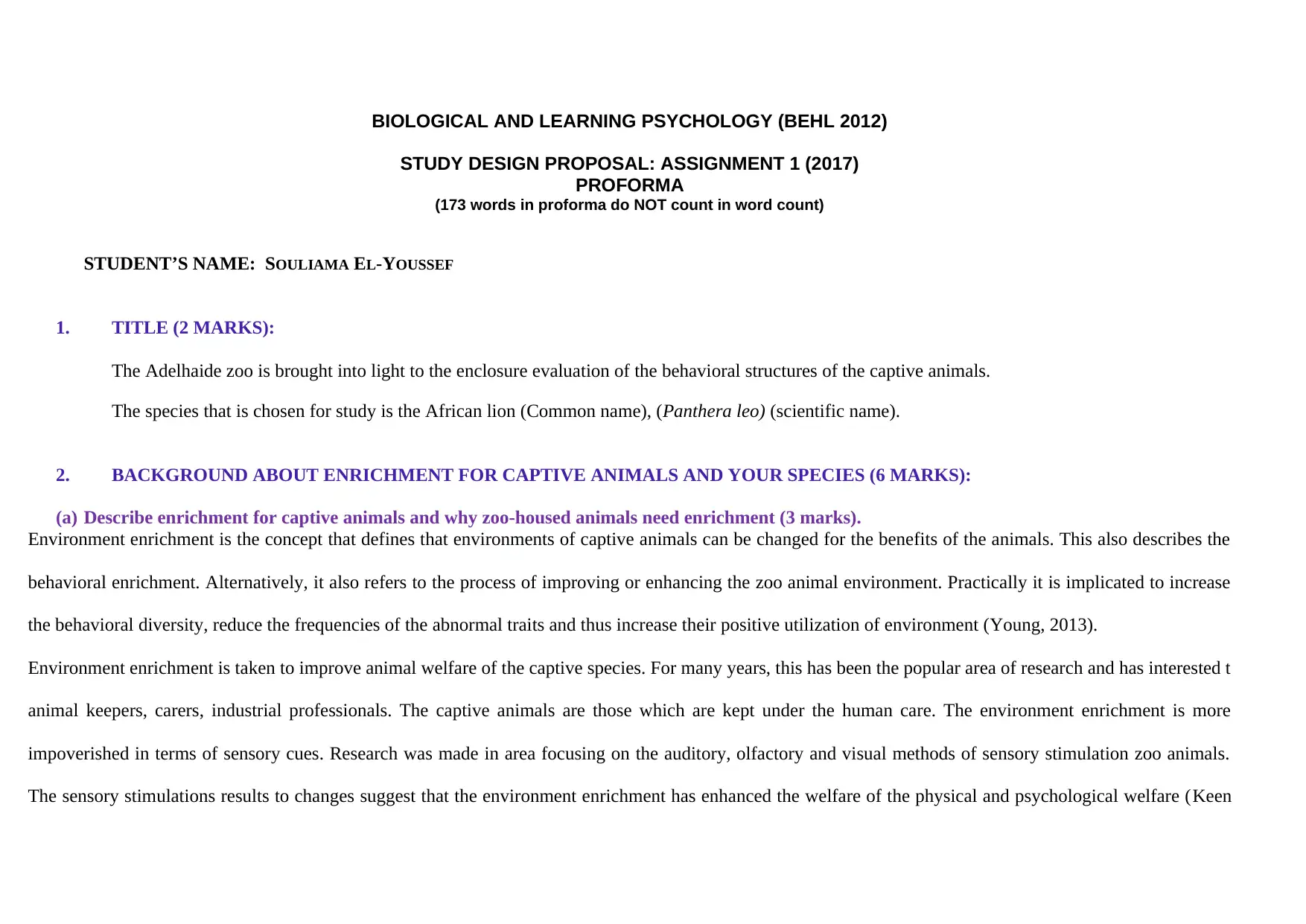
BIOLOGICAL AND LEARNING PSYCHOLOGY (BEHL 2012)
STUDY DESIGN PROPOSAL: ASSIGNMENT 1 (2017)
PROFORMA
(173 words in proforma do NOT count in word count)
STUDENT’S NAME: SOULIAMA EL-YOUSSEF
1. TITLE (2 MARKS):
The Adelhaide zoo is brought into light to the enclosure evaluation of the behavioral structures of the captive animals.
The species that is chosen for study is the African lion (Common name), (Panthera leo) (scientific name).
2. BACKGROUND ABOUT ENRICHMENT FOR CAPTIVE ANIMALS AND YOUR SPECIES (6 MARKS):
(a) Describe enrichment for captive animals and why zoo-housed animals need enrichment (3 marks).
Environment enrichment is the concept that defines that environments of captive animals can be changed for the benefits of the animals. This also describes the
behavioral enrichment. Alternatively, it also refers to the process of improving or enhancing the zoo animal environment. Practically it is implicated to increase
the behavioral diversity, reduce the frequencies of the abnormal traits and thus increase their positive utilization of environment (Young, 2013).
Environment enrichment is taken to improve animal welfare of the captive species. For many years, this has been the popular area of research and has interested t
animal keepers, carers, industrial professionals. The captive animals are those which are kept under the human care. The environment enrichment is more
impoverished in terms of sensory cues. Research was made in area focusing on the auditory, olfactory and visual methods of sensory stimulation zoo animals.
The sensory stimulations results to changes suggest that the environment enrichment has enhanced the welfare of the physical and psychological welfare (Keen
STUDY DESIGN PROPOSAL: ASSIGNMENT 1 (2017)
PROFORMA
(173 words in proforma do NOT count in word count)
STUDENT’S NAME: SOULIAMA EL-YOUSSEF
1. TITLE (2 MARKS):
The Adelhaide zoo is brought into light to the enclosure evaluation of the behavioral structures of the captive animals.
The species that is chosen for study is the African lion (Common name), (Panthera leo) (scientific name).
2. BACKGROUND ABOUT ENRICHMENT FOR CAPTIVE ANIMALS AND YOUR SPECIES (6 MARKS):
(a) Describe enrichment for captive animals and why zoo-housed animals need enrichment (3 marks).
Environment enrichment is the concept that defines that environments of captive animals can be changed for the benefits of the animals. This also describes the
behavioral enrichment. Alternatively, it also refers to the process of improving or enhancing the zoo animal environment. Practically it is implicated to increase
the behavioral diversity, reduce the frequencies of the abnormal traits and thus increase their positive utilization of environment (Young, 2013).
Environment enrichment is taken to improve animal welfare of the captive species. For many years, this has been the popular area of research and has interested t
animal keepers, carers, industrial professionals. The captive animals are those which are kept under the human care. The environment enrichment is more
impoverished in terms of sensory cues. Research was made in area focusing on the auditory, olfactory and visual methods of sensory stimulation zoo animals.
The sensory stimulations results to changes suggest that the environment enrichment has enhanced the welfare of the physical and psychological welfare (Keen
Secure Best Marks with AI Grader
Need help grading? Try our AI Grader for instant feedback on your assignments.
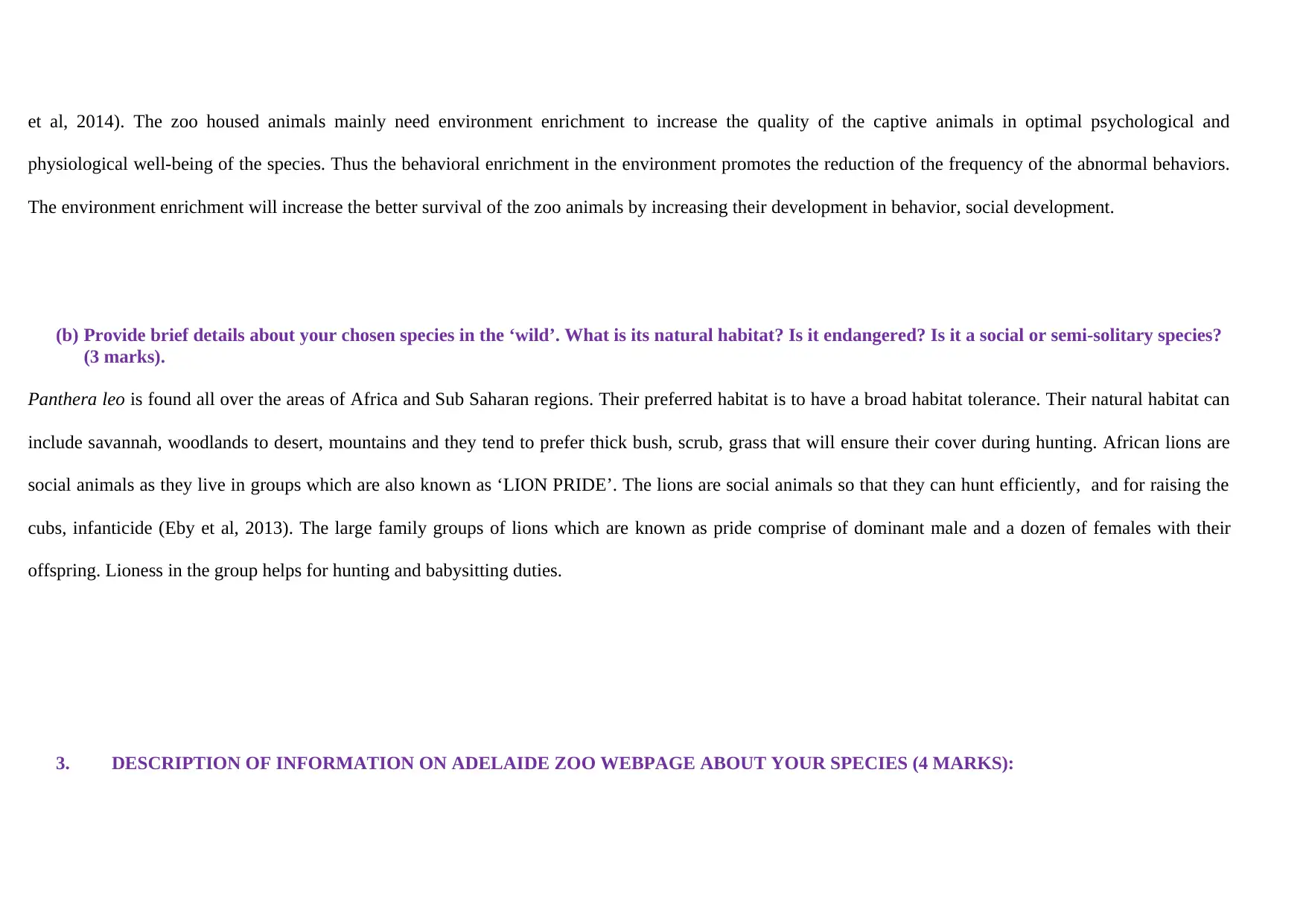
et al, 2014). The zoo housed animals mainly need environment enrichment to increase the quality of the captive animals in optimal psychological and
physiological well-being of the species. Thus the behavioral enrichment in the environment promotes the reduction of the frequency of the abnormal behaviors.
The environment enrichment will increase the better survival of the zoo animals by increasing their development in behavior, social development.
(b) Provide brief details about your chosen species in the ‘wild’. What is its natural habitat? Is it endangered? Is it a social or semi-solitary species?
(3 marks).
Panthera leo is found all over the areas of Africa and Sub Saharan regions. Their preferred habitat is to have a broad habitat tolerance. Their natural habitat can
include savannah, woodlands to desert, mountains and they tend to prefer thick bush, scrub, grass that will ensure their cover during hunting. African lions are
social animals as they live in groups which are also known as ‘LION PRIDE’. The lions are social animals so that they can hunt efficiently, and for raising the
cubs, infanticide (Eby et al, 2013). The large family groups of lions which are known as pride comprise of dominant male and a dozen of females with their
offspring. Lioness in the group helps for hunting and babysitting duties.
3. DESCRIPTION OF INFORMATION ON ADELAIDE ZOO WEBPAGE ABOUT YOUR SPECIES (4 MARKS):
physiological well-being of the species. Thus the behavioral enrichment in the environment promotes the reduction of the frequency of the abnormal behaviors.
The environment enrichment will increase the better survival of the zoo animals by increasing their development in behavior, social development.
(b) Provide brief details about your chosen species in the ‘wild’. What is its natural habitat? Is it endangered? Is it a social or semi-solitary species?
(3 marks).
Panthera leo is found all over the areas of Africa and Sub Saharan regions. Their preferred habitat is to have a broad habitat tolerance. Their natural habitat can
include savannah, woodlands to desert, mountains and they tend to prefer thick bush, scrub, grass that will ensure their cover during hunting. African lions are
social animals as they live in groups which are also known as ‘LION PRIDE’. The lions are social animals so that they can hunt efficiently, and for raising the
cubs, infanticide (Eby et al, 2013). The large family groups of lions which are known as pride comprise of dominant male and a dozen of females with their
offspring. Lioness in the group helps for hunting and babysitting duties.
3. DESCRIPTION OF INFORMATION ON ADELAIDE ZOO WEBPAGE ABOUT YOUR SPECIES (4 MARKS):
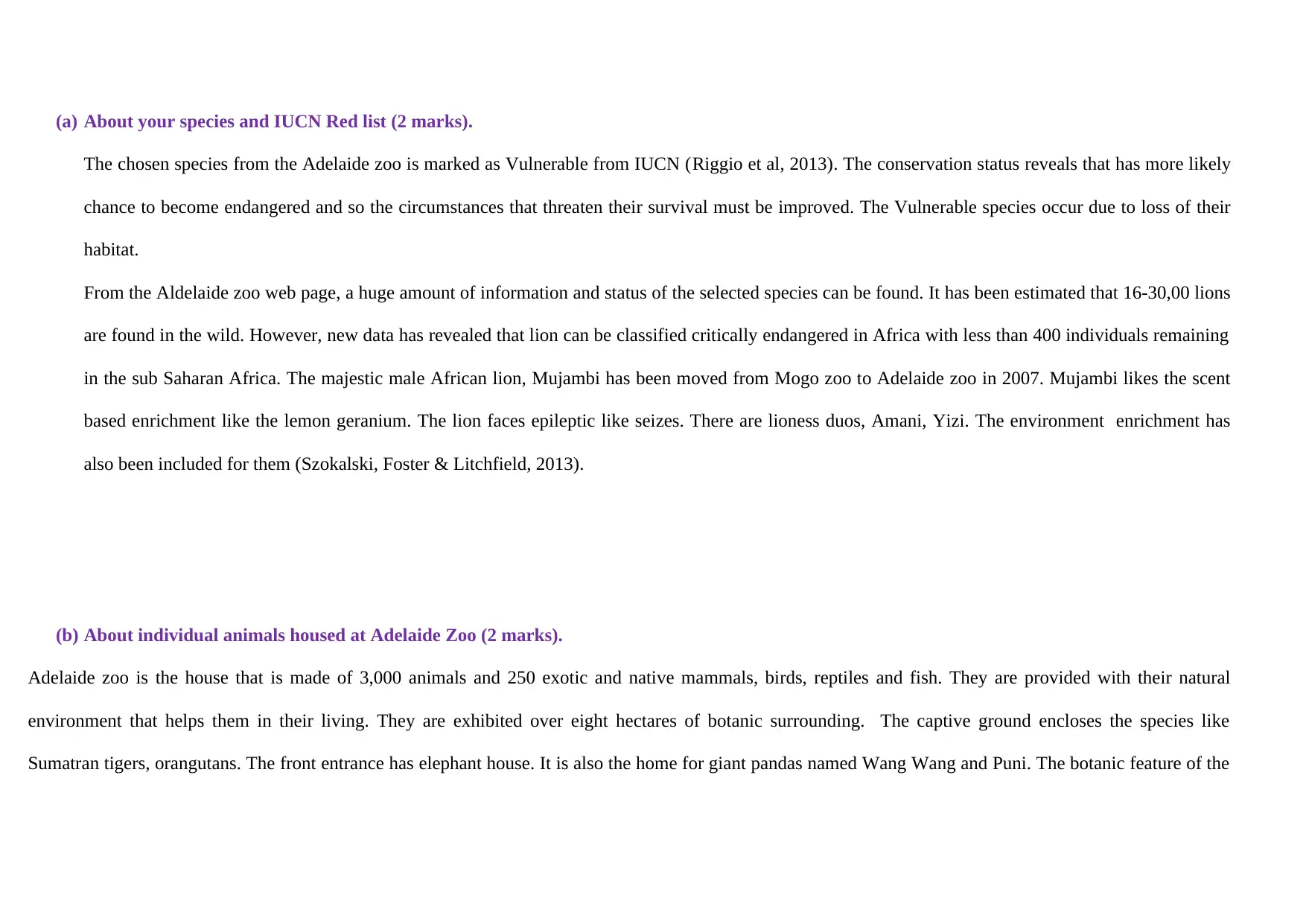
(a) About your species and IUCN Red list (2 marks).
The chosen species from the Adelaide zoo is marked as Vulnerable from IUCN (Riggio et al, 2013). The conservation status reveals that has more likely
chance to become endangered and so the circumstances that threaten their survival must be improved. The Vulnerable species occur due to loss of their
habitat.
From the Aldelaide zoo web page, a huge amount of information and status of the selected species can be found. It has been estimated that 16-30,00 lions
are found in the wild. However, new data has revealed that lion can be classified critically endangered in Africa with less than 400 individuals remaining
in the sub Saharan Africa. The majestic male African lion, Mujambi has been moved from Mogo zoo to Adelaide zoo in 2007. Mujambi likes the scent
based enrichment like the lemon geranium. The lion faces epileptic like seizes. There are lioness duos, Amani, Yizi. The environment enrichment has
also been included for them (Szokalski, Foster & Litchfield, 2013).
(b) About individual animals housed at Adelaide Zoo (2 marks).
Adelaide zoo is the house that is made of 3,000 animals and 250 exotic and native mammals, birds, reptiles and fish. They are provided with their natural
environment that helps them in their living. They are exhibited over eight hectares of botanic surrounding. The captive ground encloses the species like
Sumatran tigers, orangutans. The front entrance has elephant house. It is also the home for giant pandas named Wang Wang and Puni. The botanic feature of the
The chosen species from the Adelaide zoo is marked as Vulnerable from IUCN (Riggio et al, 2013). The conservation status reveals that has more likely
chance to become endangered and so the circumstances that threaten their survival must be improved. The Vulnerable species occur due to loss of their
habitat.
From the Aldelaide zoo web page, a huge amount of information and status of the selected species can be found. It has been estimated that 16-30,00 lions
are found in the wild. However, new data has revealed that lion can be classified critically endangered in Africa with less than 400 individuals remaining
in the sub Saharan Africa. The majestic male African lion, Mujambi has been moved from Mogo zoo to Adelaide zoo in 2007. Mujambi likes the scent
based enrichment like the lemon geranium. The lion faces epileptic like seizes. There are lioness duos, Amani, Yizi. The environment enrichment has
also been included for them (Szokalski, Foster & Litchfield, 2013).
(b) About individual animals housed at Adelaide Zoo (2 marks).
Adelaide zoo is the house that is made of 3,000 animals and 250 exotic and native mammals, birds, reptiles and fish. They are provided with their natural
environment that helps them in their living. They are exhibited over eight hectares of botanic surrounding. The captive ground encloses the species like
Sumatran tigers, orangutans. The front entrance has elephant house. It is also the home for giant pandas named Wang Wang and Puni. The botanic feature of the
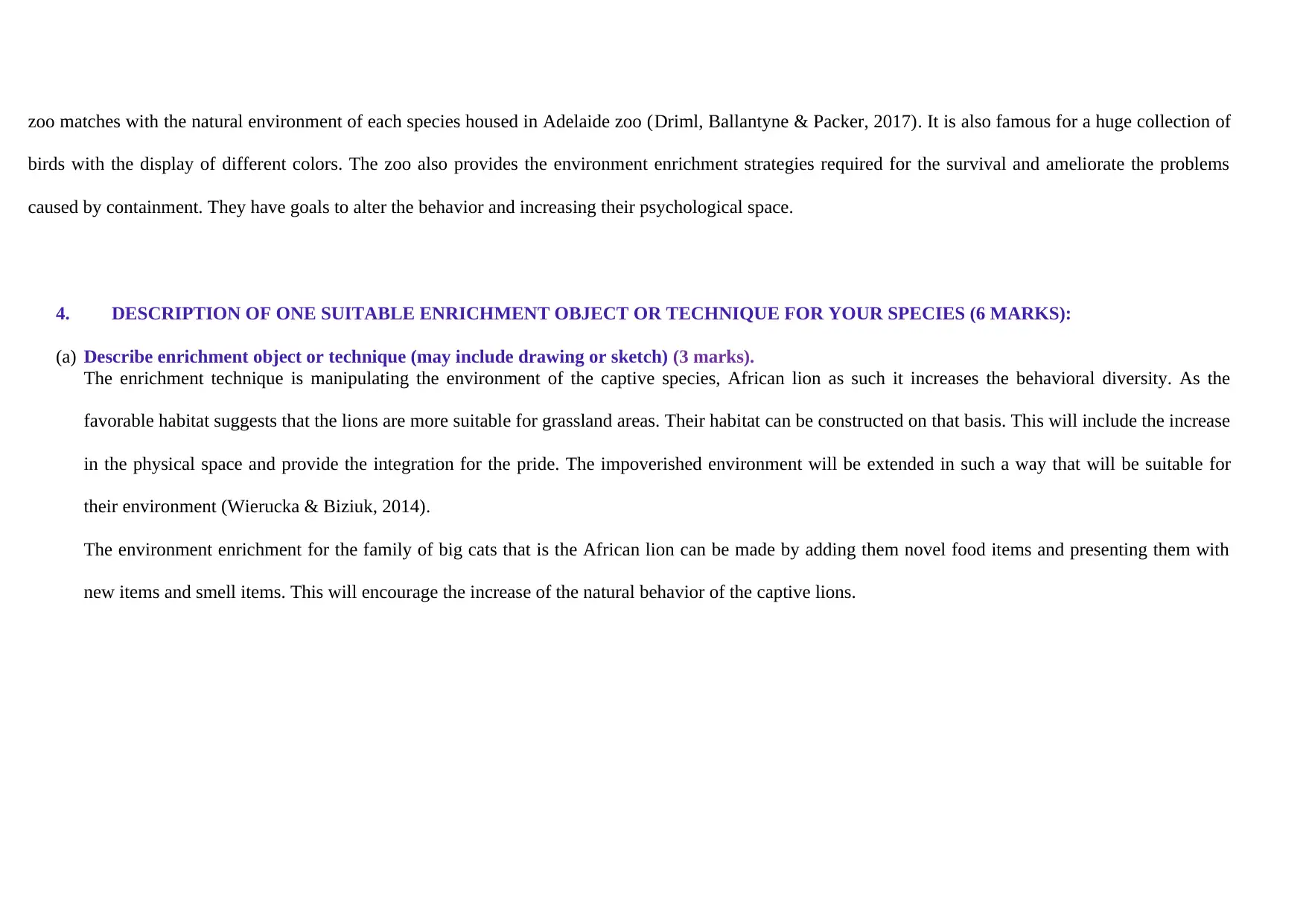
zoo matches with the natural environment of each species housed in Adelaide zoo (Driml, Ballantyne & Packer, 2017). It is also famous for a huge collection of
birds with the display of different colors. The zoo also provides the environment enrichment strategies required for the survival and ameliorate the problems
caused by containment. They have goals to alter the behavior and increasing their psychological space.
4. DESCRIPTION OF ONE SUITABLE ENRICHMENT OBJECT OR TECHNIQUE FOR YOUR SPECIES (6 MARKS):
(a) Describe enrichment object or technique (may include drawing or sketch) (3 marks).
The enrichment technique is manipulating the environment of the captive species, African lion as such it increases the behavioral diversity. As the
favorable habitat suggests that the lions are more suitable for grassland areas. Their habitat can be constructed on that basis. This will include the increase
in the physical space and provide the integration for the pride. The impoverished environment will be extended in such a way that will be suitable for
their environment (Wierucka & Biziuk, 2014).
The environment enrichment for the family of big cats that is the African lion can be made by adding them novel food items and presenting them with
new items and smell items. This will encourage the increase of the natural behavior of the captive lions.
birds with the display of different colors. The zoo also provides the environment enrichment strategies required for the survival and ameliorate the problems
caused by containment. They have goals to alter the behavior and increasing their psychological space.
4. DESCRIPTION OF ONE SUITABLE ENRICHMENT OBJECT OR TECHNIQUE FOR YOUR SPECIES (6 MARKS):
(a) Describe enrichment object or technique (may include drawing or sketch) (3 marks).
The enrichment technique is manipulating the environment of the captive species, African lion as such it increases the behavioral diversity. As the
favorable habitat suggests that the lions are more suitable for grassland areas. Their habitat can be constructed on that basis. This will include the increase
in the physical space and provide the integration for the pride. The impoverished environment will be extended in such a way that will be suitable for
their environment (Wierucka & Biziuk, 2014).
The environment enrichment for the family of big cats that is the African lion can be made by adding them novel food items and presenting them with
new items and smell items. This will encourage the increase of the natural behavior of the captive lions.
Secure Best Marks with AI Grader
Need help grading? Try our AI Grader for instant feedback on your assignments.
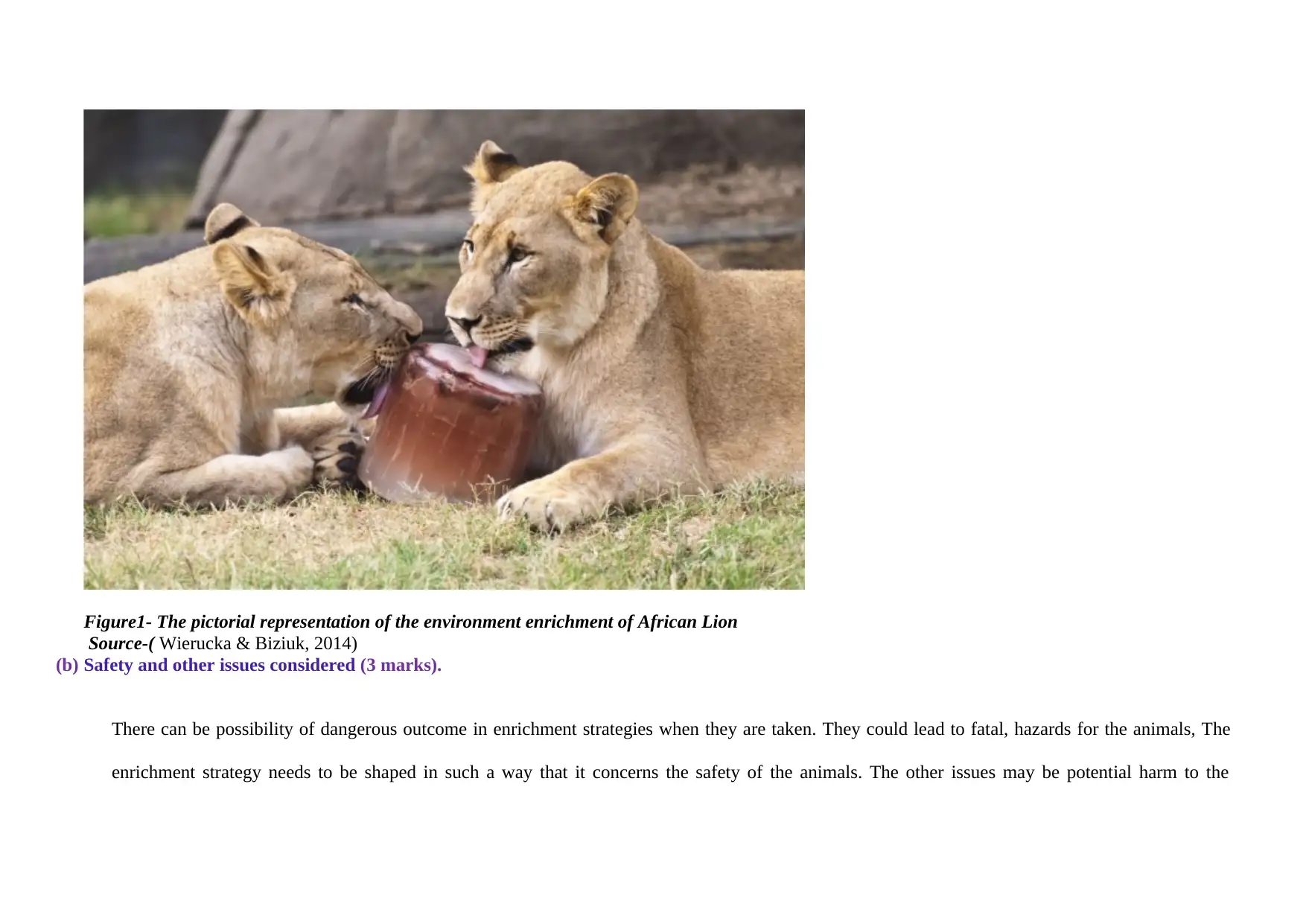
Figure1- The pictorial representation of the environment enrichment of African Lion
Source-( Wierucka & Biziuk, 2014)
(b) Safety and other issues considered (3 marks).
There can be possibility of dangerous outcome in enrichment strategies when they are taken. They could lead to fatal, hazards for the animals, The
enrichment strategy needs to be shaped in such a way that it concerns the safety of the animals. The other issues may be potential harm to the
Source-( Wierucka & Biziuk, 2014)
(b) Safety and other issues considered (3 marks).
There can be possibility of dangerous outcome in enrichment strategies when they are taken. They could lead to fatal, hazards for the animals, The
enrichment strategy needs to be shaped in such a way that it concerns the safety of the animals. The other issues may be potential harm to the
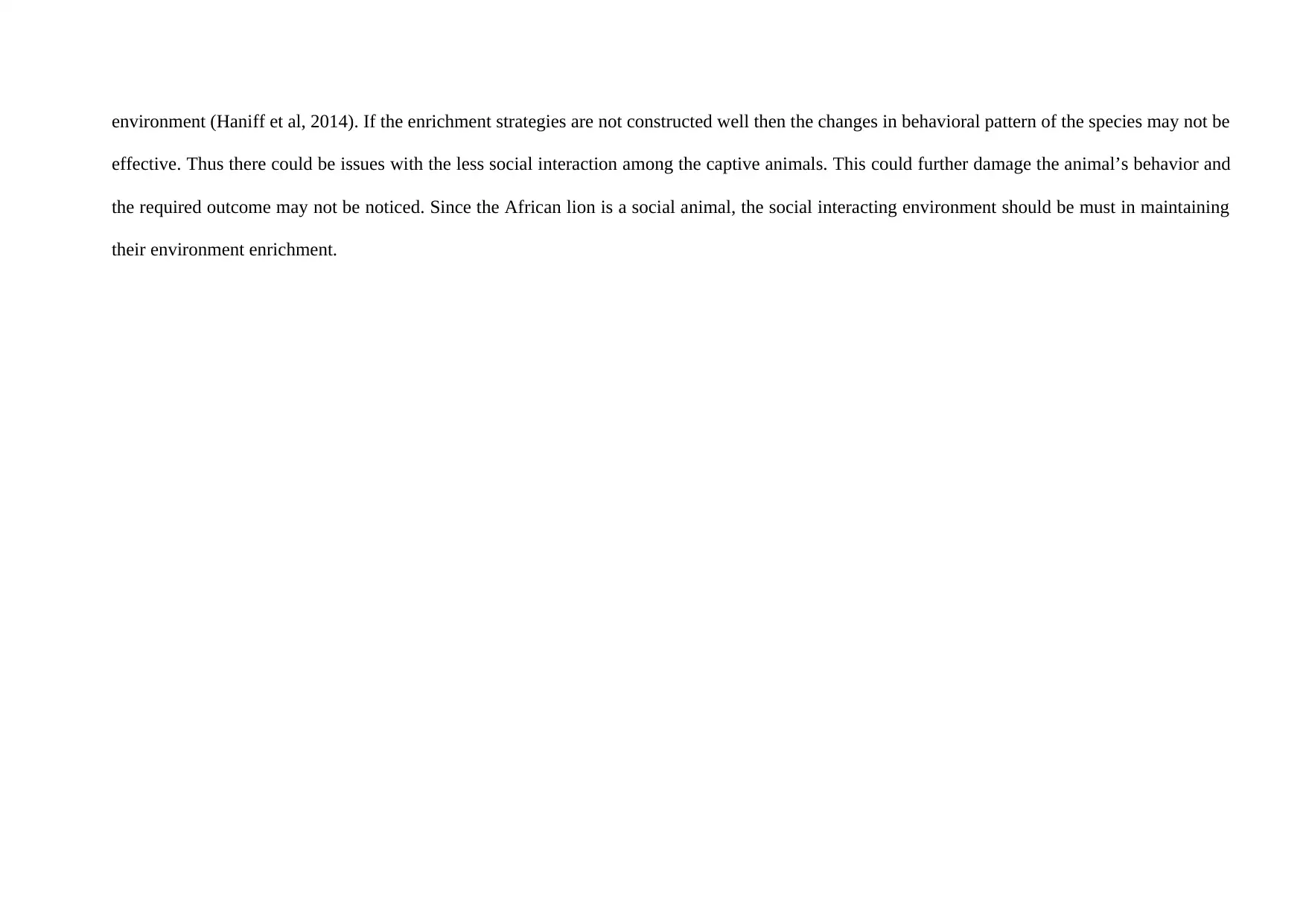
environment (Haniff et al, 2014). If the enrichment strategies are not constructed well then the changes in behavioral pattern of the species may not be
effective. Thus there could be issues with the less social interaction among the captive animals. This could further damage the animal’s behavior and
the required outcome may not be noticed. Since the African lion is a social animal, the social interacting environment should be must in maintaining
their environment enrichment.
effective. Thus there could be issues with the less social interaction among the captive animals. This could further damage the animal’s behavior and
the required outcome may not be noticed. Since the African lion is a social animal, the social interacting environment should be must in maintaining
their environment enrichment.
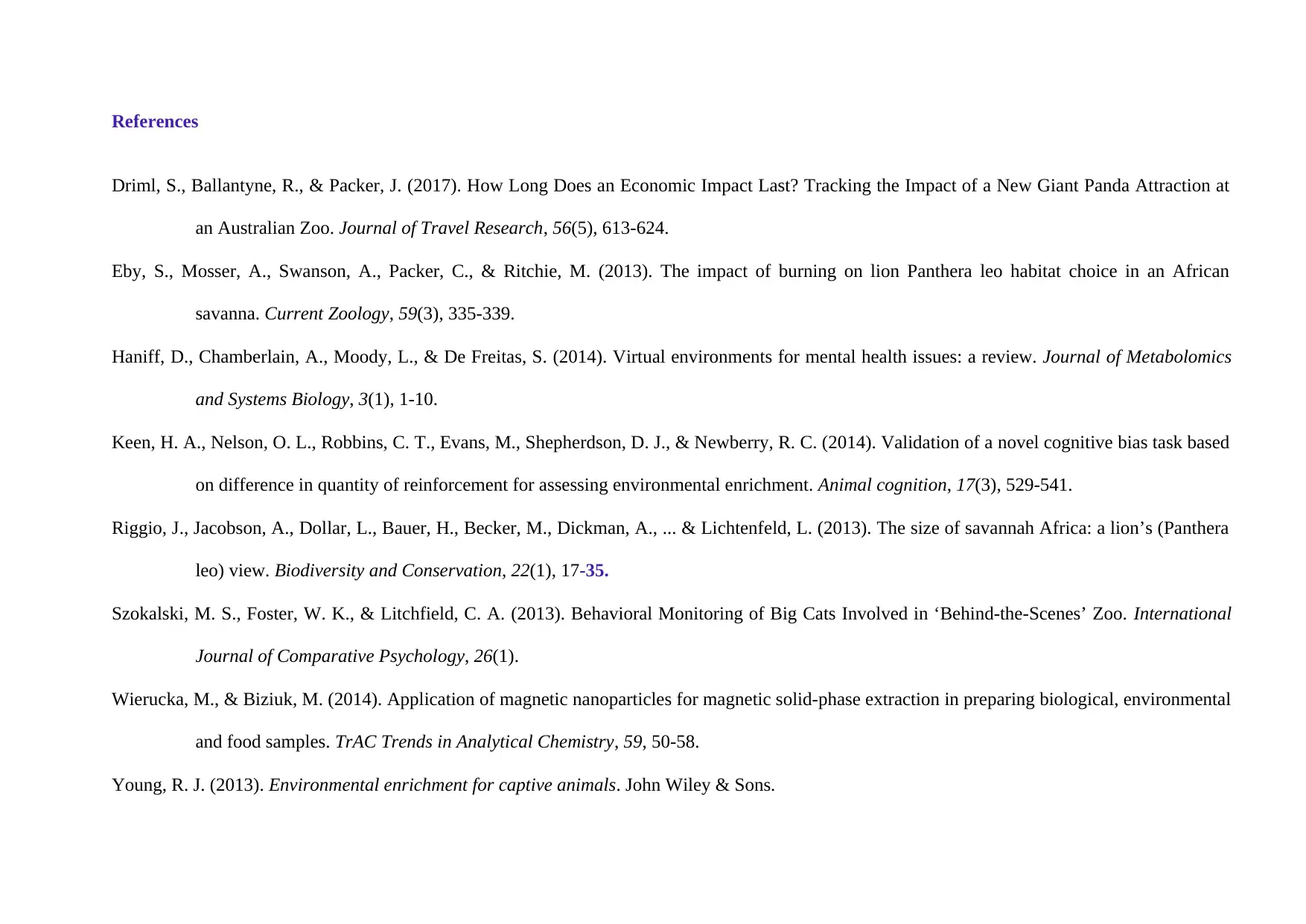
References
Driml, S., Ballantyne, R., & Packer, J. (2017). How Long Does an Economic Impact Last? Tracking the Impact of a New Giant Panda Attraction at
an Australian Zoo. Journal of Travel Research, 56(5), 613-624.
Eby, S., Mosser, A., Swanson, A., Packer, C., & Ritchie, M. (2013). The impact of burning on lion Panthera leo habitat choice in an African
savanna. Current Zoology, 59(3), 335-339.
Haniff, D., Chamberlain, A., Moody, L., & De Freitas, S. (2014). Virtual environments for mental health issues: a review. Journal of Metabolomics
and Systems Biology, 3(1), 1-10.
Keen, H. A., Nelson, O. L., Robbins, C. T., Evans, M., Shepherdson, D. J., & Newberry, R. C. (2014). Validation of a novel cognitive bias task based
on difference in quantity of reinforcement for assessing environmental enrichment. Animal cognition, 17(3), 529-541.
Riggio, J., Jacobson, A., Dollar, L., Bauer, H., Becker, M., Dickman, A., ... & Lichtenfeld, L. (2013). The size of savannah Africa: a lion’s (Panthera
leo) view. Biodiversity and Conservation, 22(1), 17-35.
Szokalski, M. S., Foster, W. K., & Litchfield, C. A. (2013). Behavioral Monitoring of Big Cats Involved in ‘Behind-the-Scenes’ Zoo. International
Journal of Comparative Psychology, 26(1).
Wierucka, M., & Biziuk, M. (2014). Application of magnetic nanoparticles for magnetic solid-phase extraction in preparing biological, environmental
and food samples. TrAC Trends in Analytical Chemistry, 59, 50-58.
Young, R. J. (2013). Environmental enrichment for captive animals. John Wiley & Sons.
Driml, S., Ballantyne, R., & Packer, J. (2017). How Long Does an Economic Impact Last? Tracking the Impact of a New Giant Panda Attraction at
an Australian Zoo. Journal of Travel Research, 56(5), 613-624.
Eby, S., Mosser, A., Swanson, A., Packer, C., & Ritchie, M. (2013). The impact of burning on lion Panthera leo habitat choice in an African
savanna. Current Zoology, 59(3), 335-339.
Haniff, D., Chamberlain, A., Moody, L., & De Freitas, S. (2014). Virtual environments for mental health issues: a review. Journal of Metabolomics
and Systems Biology, 3(1), 1-10.
Keen, H. A., Nelson, O. L., Robbins, C. T., Evans, M., Shepherdson, D. J., & Newberry, R. C. (2014). Validation of a novel cognitive bias task based
on difference in quantity of reinforcement for assessing environmental enrichment. Animal cognition, 17(3), 529-541.
Riggio, J., Jacobson, A., Dollar, L., Bauer, H., Becker, M., Dickman, A., ... & Lichtenfeld, L. (2013). The size of savannah Africa: a lion’s (Panthera
leo) view. Biodiversity and Conservation, 22(1), 17-35.
Szokalski, M. S., Foster, W. K., & Litchfield, C. A. (2013). Behavioral Monitoring of Big Cats Involved in ‘Behind-the-Scenes’ Zoo. International
Journal of Comparative Psychology, 26(1).
Wierucka, M., & Biziuk, M. (2014). Application of magnetic nanoparticles for magnetic solid-phase extraction in preparing biological, environmental
and food samples. TrAC Trends in Analytical Chemistry, 59, 50-58.
Young, R. J. (2013). Environmental enrichment for captive animals. John Wiley & Sons.
Paraphrase This Document
Need a fresh take? Get an instant paraphrase of this document with our AI Paraphraser
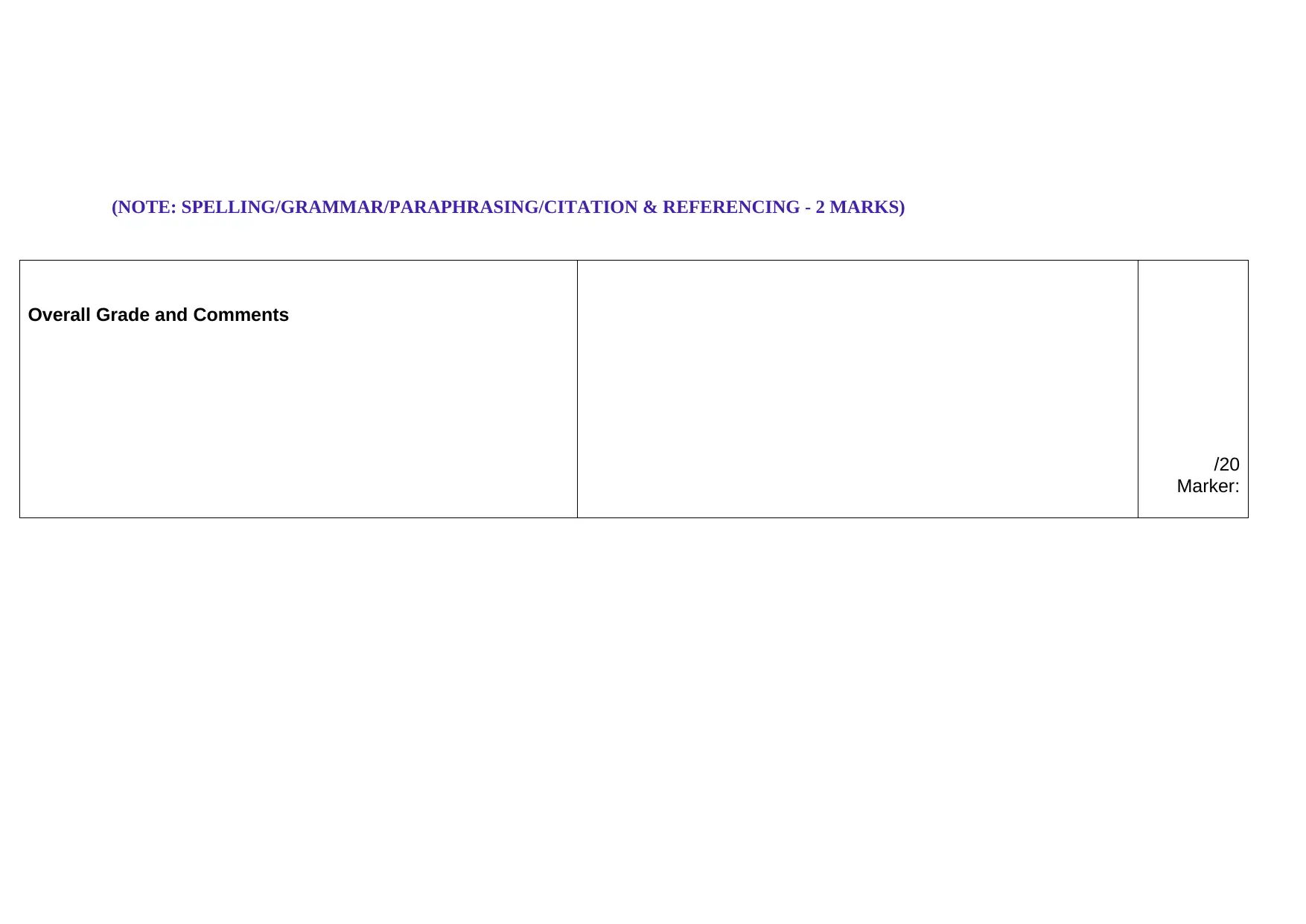
(NOTE: SPELLING/GRAMMAR/PARAPHRASING/CITATION & REFERENCING - 2 MARKS)
Overall Grade and Comments
/20
Marker:
Overall Grade and Comments
/20
Marker:
1 out of 8
Your All-in-One AI-Powered Toolkit for Academic Success.
+13062052269
info@desklib.com
Available 24*7 on WhatsApp / Email
![[object Object]](/_next/static/media/star-bottom.7253800d.svg)
Unlock your academic potential
© 2024 | Zucol Services PVT LTD | All rights reserved.